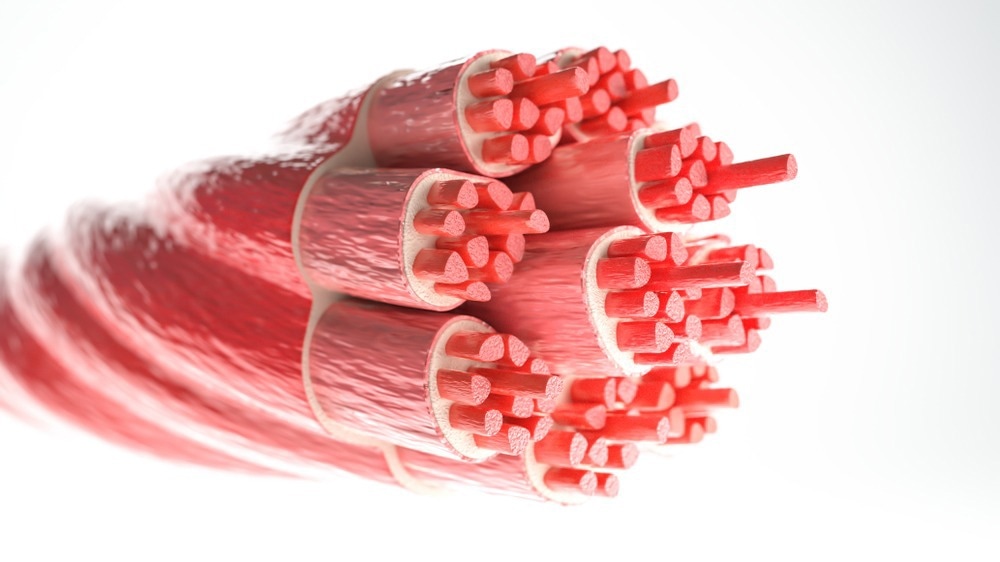In an article recently published in the journal Carbohydrate Polymers, a dual-network self-healing hydrogel was developed via a nature-inspired strategy. The hydrogels were based on flexible poly [acrylamide-co-(acrylic acid)] (poly (AAm-co-AAc)), and rigid graphene oxide-functionalized nanocellulose (GO@NC) networks were integrated into each other to result in a self-healing hydrogel.

Study: Muscle-inspired dual-network self-healing hydrogels composed of graphene oxide@nanocellulose and poly(AAm-co-AAc). Image Credit: Crevis/Shutterstock.com
A pre-stretching method was used to form an anisotropic architecture that mimicked the shape of the muscle. Incorporating a poly (AAm-co-AAc) flexible network relieved the stiffness in the GO@NC network with improved elongation at a break from 86.2% to 748%. Compared to poly (AAm-co-AAc), the average rupture tensile strength of the dual-network hydrogel improved by 228.6 %.
Furthermore, the dual-crosslinked strategy endowed the GO@NC-poly (AAm-co-AAc) self-healing hydrogel with stable, fast, repeatable properties with 85% healing efficiency after 600 seconds of self-healing. The prepared self-healing hydrogel also maintained about 76.2% of initial strength after breaking and self-healing for up to 10 cycles.
The excellent self-healing capacity of the developed hydrogel mimicked the muscle function. Thus, the self-healing hydrogels were applied to achieve stable, real-time, and long-term sensing in smart wearable strain sensors with a gauge factor of 5.13 and as a green recyclable adsorbent to purify Sudan IV wastewater.
Nature-Inspired Self-Healing Hydrogel
Nature has inspired the development of various ingenious structures and paved the way to resolve the limitation of materials and engineering technologies, including spider silk-inspired water collection materials and lotus leaf-inspired self-cleaning surfaces. The animal muscle is a strong and elastic biomaterial that can undergo self-healing on damage and serves as a reference to create novel and robust self-healing hydrogel.
Self-healing hydrogels are spontaneously regenerated through dynamic covalent cross-linkages. The idea of self-healing hydrogel was inspired by nature, where the function of self-healed material could be maintained by inducing it through an external stimulus. The self-healing hydrogel can repair itself and exhibit a prolonged life span even after being exposed to external forces.
Self-healing hydrogels with injectability reduce pain while maintaining the wound in its natural state and extending the life span of the dressing material. The self-healing hydrogel has the capability of repairing itself automatically, either completely or partially after damage.
The dual-crosslinked strategy in supramolecular chemistry involves introducing a flexible network into the rigid network to reduce mechanical stiffness. This dual-crosslinked flexible‒rigid network facilitates an effective energy dissipation via a stress transfer mechanism, ensuring excellent mechanical flexibility in the hydrogel. Moreover, the dual-crosslinked strategy solves the restriction of NC hydrogels and reduces structural stiffness.
Dual-Network Self-Healing Hydrogel
In the present work, dual-crosslinked hydrogels based on poly (AAm-co-AAc) and GO@NC were constructed, and a pre-stretching treatment was applied to develop an anisotropic structure in the shape of a muscle. The flexible poly (AAm-co-AAc) was allowed to penetrate the GO@NC network to generate GO@NC-poly (AAm-co-AAc) dual-network self-healing hydrogel.
This penetration helped relieve the stiffness in GO@NC, and the average elongation at break improved from 86.2% in GO@NC to 748% in GO@NC-poly (AAm-co-AAc) self-healing hydrogels. The rupture tensile strength in this dual-network self-healing hydrogel was increased by 228.6% compared to poly (AAm-co-AAc) hydrogels.
Furthermore, the GO@NC-poly (AAm-co-AAc) self-healing hydrogel mimicked the muscular tissue in terms of its self-healing ability. The developed self-healing hydrogel was applied in smart wearable strain sensors to monitor human motions and to remove Sudan IV from wastewater.
The self-healing property of GO@NC-poly (AAm-co-AAc) hydrogel was evaluated using an elliptic hydrogel sample sliced into two halves. One-half of the sliced hydrogel was coated with titanium dioxide (TiO2) pigment. The two halved pieces were kept in contact without introducing any external force for 600 seconds at room temperature. Consequently, the two halves were self-healed and were found to be inseparable even after applying large stress through stretching.
Conclusion
To summarize, a dual-network self-healing hydrogel was developed via a dual-crosslinked technique. The stiff GO@NC network was allowed to penetrate through flexible poly (AAm-co-AAc) network to address the limitations of poor flexibility, fragility, and low stretchability of GO@NC hydrogels.
The dual-network self-healing hydrogel mimicked the muscle in terms of rapid and stable self-healing ability and achieved an elongation at a break of 748% and an average rupture tensile strength of 0.608 megapascals with 85% restoring capacity followed by self-healing for 600 seconds. Despite subjecting the muscle-inspired hydrogel to 10 cycles of breaking‒self-healing, the tensile strength was maintained at 76.2% of the initial value.
When the prepared hydrogels were used as smart wearable strain sensors, they achieved real-time, stable, and long-term motion sensing of various human body parts. Moreover, as a green adsorbent, the hydrogel has achieved a 90.2% Sudan IV removal from wastewater with excellent recoverability.
Reference
Su, J., Zhang, L., Wan, C., Deng, Z., Wei, S., Yong, K. T., Wu, Y. (2022). Muscle-inspired dual-network self-healing hydrogels composed of graphene oxide@ nanocellulose and poly (AAm-co-AAc). Carbohydrate Polymers. https://www.sciencedirect.com/science/article/pii/S0144861722008104
Disclaimer: The views expressed here are those of the author expressed in their private capacity and do not necessarily represent the views of AZoM.com Limited T/A AZoNetwork the owner and operator of this website. This disclaimer forms part of the Terms and conditions of use of this website.